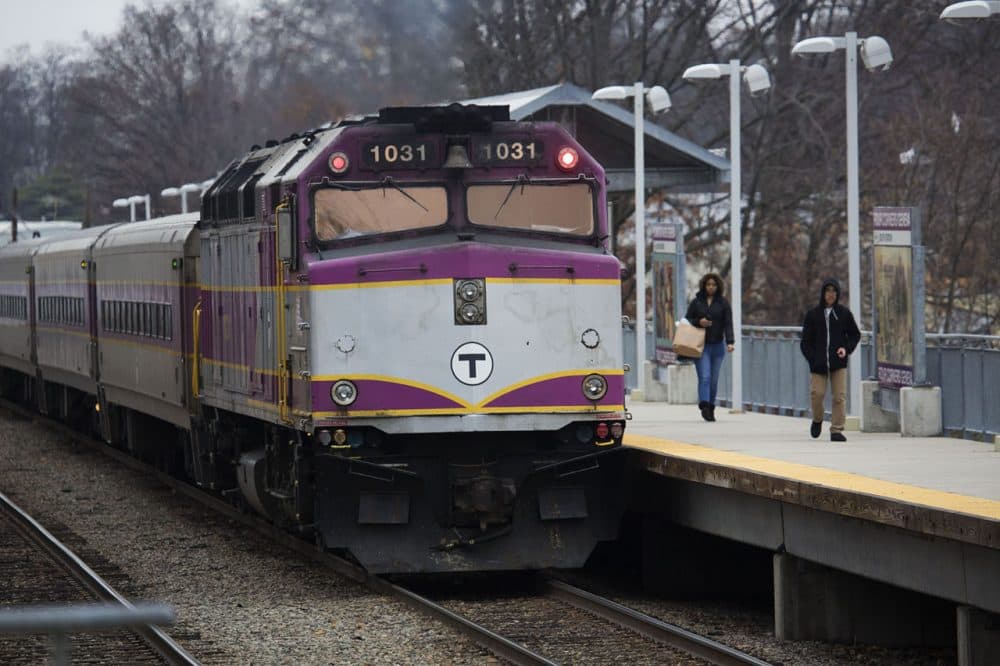Advertisement
As It Marks 100 Years, The Boston Foundation Grapples With New Issues
Resume
Five days a week Sherri Tibbs boards the train at the new Four Corners station. She rides the smooth commuter train from Dorchester reading a book, or closes her eyes until reaching her station.
“It means I get home when I want to get home,” Tibbs said during a weekday train ride from South Station to the Four Corners/Geneva Avenue stop. “After a long day I’m home within half an hour, if that.”
The Boston Foundation has supported causes large and small over its 100 years — from the Greater Boston Food Bank to the push for charter schools.
But one of its proudest moments in recent years was the opening of three new stations on the commuter rail's Fairmount Line, with one more on the horizon.
Now T rider Tibbs doesn’t have to transfer or sit on buses in traffic. She says the new stop has made life simpler.
“I’m not aggravated in the morning on my way to work, you know, coming home aggravated," she said.
The foundation sees the entire nine-mile Fairmount corridor — which runs from the south of Hyde Park to the heart of downtown -- as vital to the city’s well-being. So it’s granting millions of dollars to groups doing work along the corridor.
But with the improvement of neighborhoods like Four Corners in Dorchester, some residents say rising rents are threatening to push them out. It’s a balancing act happening in much of Boston — the improvements of the city beset by ever-increasing rents — and some say the Boston Foundation’s response will define its presence in the neighborhoods as it begins its 101st year.
A Foundation Born In 20th Century Boston
Paul Grogan stands in his office in the 10th floor of a building in the Back Bay. The foundation’s president and CEO is surrounded by pictures of himself with Thomas Menino, George H. W. Bush and, perhaps most importantly, Kevin White, the late Boston mayor who brought Grogan to the city in the early 1970s.
“I think the record shows that the foundation has been able to have significant impact across a wide spectrum of issues,” Grogan said. “And as we celebrate our 100th birthday we’re particularly proud of that.”
The foundation was started in 1915. In the beginning it dealt with the needs of families sending their men off to war, as well as the needs of thousands of immigrants pouring into Boston. By the middle of the century, Boston was reeling from the Great Depression and two world wars. It had lost the industries that once powered its economy, and its population would shrink from 800,000 to less than 600,000 in the coming decades.
To assist with the turnaround, the foundation funded the Boston Coordinating Committee — a group of Boston elites known as “the Vault." They helped launch the Boston Redevelopment Authority and usher in the so-called “New Boston."
The foundation has provided seed capital for nonprofits that are now household names in Boston: the Boys & Girls Club, Save The Harbor/Save The Bay, Action for Boston Community Development, to name a few of the hundreds of groups supported by the foundation.
“We couldn’t imagine the world without public television, or the New England Aquarium, or neighborhood health centers,” Grogan said. “But it took somebody to make bets on those ideas, and boy, that’s been I think a very good thing for the city.”
“It took somebody to make bets on those ideas, and boy, that’s been I think a very good thing for the city.”
Paul Grogan
Grogan came to the foundation in 2001, another key point in Boston's history.
“The city was, despite that recession, clearly on the path of a renaissance,” Grogan recalled. “A lot of things were getting better, the city was becoming much more vital, and so it struck us that there would be an opportunity to extend the benefits of that urban revival to a broader population.”
A decade and a half later, Grogan attributes much of the city's successes to groups — community economic development corporations — supported by the foundation.
“It’s very hard now to find physical blight in Boston,” Grogan said. “So I think that’s a major achievement.”
The foundation’s assets now total roughly $1 billion, and for each of the last three years it has given out more than $100 million in grants. It also does advocacy work — Grogan is a registered lobbyist on Beacon Hill — and funds research on issues including housing to economic inequality.
The Fairmount Corridor
The foundation reported last year that unemployment along the Fairmount corridor was more than 17 percent for the 200,000 people living there. Homicide rates were twice the city average.
And the train was yet another grievance in the community. Built in the 19th century, the Fairmount Line stopped providing passenger service in the mid-20th century. When it returned in 1979, it passed through some of the city's poorest neighborhoods without stopping.
“Minus the train, we’re spending more time in transporting ourselves and commuting than other communities,” said Mela Bush Miles, who chairs the the Fairmount Indigo Transit Coalition, a group that campaigned for the new stops.
“And right up the middle of our community was this lifeline, the infrastructure in the tracks and trains, that were going right past us and we couldn’t get on,” said Miles, also a community organizer at the Greater Four Corners Action Coalition.
In 2006, the state agreed to build new stations along the Fairmount Line.
Two existing stations were also rebuilt as part of the improvements.
An alliance of community groups pressured the state to follow through on its promise, and in 2013, three of four new stops came online. Those included the Four Corners/Geneva Avenue, Newmarket and Talbot Avenue stations. The fourth, Blue Hill Avenue station in Mattapan, is slated to open in June of 2017.
The Boston Foundation didn't set the agenda in the fight for the Fairmount stops, but it funded the groups that did.
“What we’ve really been doing is supporting the community’s vision around bringing better transit equity to the region,” said Becky Koepnick, the foundation’s director of neighborhoods and housing.
The support goes beyond transit equity. Since the new stops opened on the Fairmount Line, the foundation has invested more than $7 million in 21 groups along the corridor. The work ranges from affordable housing and the arts to health care and entrepreneurship.
The new train stations are a win no doubt, but Koepnick says new problems are arising.
“Now that there is somewhat regular service in this neighborhood, folks are really concerned about: ‘Well what does that mean? Is there going to be gentrification and displacement?’ ” Koepnick said. “So we’re trying to make sure that this line really benefits the folks who live there.”
'The Train, It Started The Gentrification'
Today, the Four Corners neighborhood in Dorchester is in movement. There's colorful artwork on the bridge over the new train station, an array of small businesses with storefronts on Washington Street, and workers building a new housing development just blocks from the new station.
But for resident Mechelle Merritt, the new shine has a dark side.
“As of last week I received an eviction notice,” Merritt said.
Merritt lives and works blocks away from the new Four Corners/Geneva Avenue station — a situation she doesn’t want to give up. She says "the train, it started the gentrification.”
“It was an epidemic like, everybody who I know received a 30 day notice," she said. "Everybody I became close friends with in the area, they moved.”
Merritt is an artist at Dorchester Arts Collaborative, a group that operates a shiny new gallery space across the street from the Four Corners stop.
Another artist at the gallery space is Kenyatta Blue. Blue says the work of the Boston Foundation will be defined by its response to the housing problem.
“I’d say that’s yet to be seen, their real impact,” Blue said. “Because this is the time when it's really going to be measured. ... What it really comes down to is what they're going to put more money into: the research to prevent it, or the programs that are supporting the gentrification.”
The foundation’s research shows that over the last 25 years, housing costs have risen more than 50 percent, adjusted for inflation. And during that period, real income has actually gone down 4 percent.
But it’s less clear the extent to which displacement is occurring in neighborhoods such as Four Corners. CEO Grogan says the foundation wants a better grasp of so-called gentrification.
“It is one of these things that people fear, sometimes out of proportion to the real threat,” Grogan said. “So one of the things we’re doing, through some research that’s underway, is really trying to find out, what is really happening here. And then we can respond accordingly.”
As the Boston Foundation moves into its 101st year, the high cost of housing has become one of its top concerns. But Grogan says he'd rather deal with housing costs than with the urban blight that occupied the foundation for much of its first 100 years.
Editor's Note: The Boston Foundation is an underwriter of WBUR.
This segment aired on December 31, 2015.
